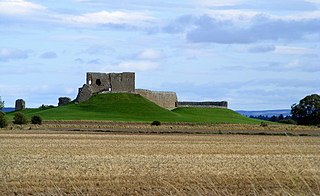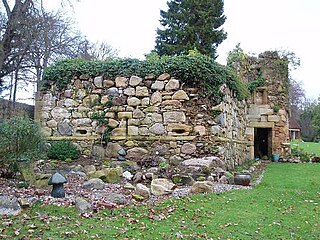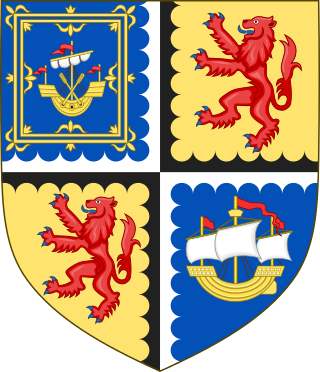
William Sutherland, 9th of Duffus (died 1616) was a member of the Scottish nobility and a cadet of the Clan Sutherland.

William Sutherland, 9th of Duffus (died 1616) was a member of the Scottish nobility and a cadet of the Clan Sutherland.
He was the second eldest son of Alexander Sutherland, 8th of Duffus and his wife Janet, daughter of James Grant of Freuchie. [1]
In 1579, he was infeft in the lands of Duffus and Greschip, near Elgin, Moray, as heir of his father, the deceased Alexander Sutherland. He also received formal possession of Quarrelwood which had belonged to his grandfather, William Sutherland, 7th of Duffus who had died in 1543. However, he appears to have previously succeeded by right, if not formally, as he appears as "now of Duffus" on 18 June 1574, when he was directed by the Lords of Session to fulfill the terms of the marriage contracts that his father and elder brother had entered into with George Sinclair, 4th Earl of Caithness. He later ratified the existing bond his great-grandfather William Sutherland, 6th of Duffus had entered into with Alexander Gordon, Master of Sutherland, a writ that related to the barony of Skelbo, which he held from the Earls of Sutherland. However, in 1588 he also erected the lands of Duffus, Quarrelwood, Greschip and others that he held near Elgin into a new barony called the barony of Duffus. [2]
In 1606, he entered into an agreement and arbitration with the burgh of Dornoch, the terms of which the boundaries between the lands of the town and his lands of Skelbo and Pronsy were fixed and amicably settled. [2]
At the instance of William Sutherland, 9th of Duffus, a commission was granted to the Earl of Sutherland along with Robert Munro, 18th Baron of Foulis and others on 15 March 1614, for them to apprehend three men who had murdered a certain Donald Angus Gairson and who had failed to appear before the Justice on the day appointed to answer the charge against them. The murderers were captured and put on trial. [3]
William Sutherland, 9th of Duffus died in 1616. [2]
William Sutherland, 9th of Duffus married firstly, Margaret, daughter of George Sinclair, 4th Earl of Caithness. It is not known when she died, but he married secondly, Margaret, daughter of William Mackintosh, 15th of Mackintosh. [4] His children were: [2]

Clan Sutherland also known as House of Sutherland is a Highland Scottish clan whose traditional territory is the shire of Sutherland in the far north of Scotland. The chief of the clan was also the powerful Earl of Sutherland, however in the early 16th century this title passed through marriage to a younger son of the chief of Clan Gordon. The current chief is Alistair Sutherland who holds the title Earl of Sutherland.

Dingwall or Dingwell is a Scottish surname but is of Viking origin. One of the most prominent families by the name of Dingwall in Scotland were the Dingwalls of Kildun who were vassals of the Earl of Ross and also septs of the Clan Munro, a Scottish clan of the Scottish Highlands.
Colonel Robert Munro of Foulis, also known as the Black Baron, was traditionally the 18th Baron of Foulis in Scotland. He was a soldier of fortune, who served in Germany under the banners of Gustavus Adolphus, king of Sweden. It is not certain how he got his epithet of the 'Black Baron', but quite possibly it was from the colour of his hair rather than any perceived martial ferocity. Although this Robert Munro is traditionally 18th Baron and 21st overall chief of the Clan Munro, he is only the 11th Munro chief that can be proved by contemporary evidence.
The Munros of Milntown were a family cadet branch of the Highland Clan Munro. As the earliest recorded cadet branch of the Munro chiefs, the Munros of Milntown were the 'senior' cadet branch of the clan, and spawned many cadet branches. They were frequently recorded as 'Monro' as well as Munro. The Munros of Milntown are notable for being involved in events concerning the history of the late Middle Ages in the Scottish Highlands.

The title Lord Duffus was created by Charles II in the Peerage of Scotland on 8 December 1650 for Alexander Sutherland. He was a descendant of the 4th Earl of Sutherland, who fell in battle in 1333. The title is now extinct, although there may be male-line Sutherlands descended from earlier lairds of Duffus.

Sir George Munro, 1st of Newmore (1602–1693) was a 17th-century Scottish soldier and member of parliament from the Clan Munro, Ross-shire, Scotland. He was seated at Newmore Castle. Between 1629 and 1634 Munro held command in the Swedish army during the Thirty Years' War, and from 1642 in the Scottish Covenanter army during the Irish Confederate Wars before changing his allegiance to the Royalist cause of Charles I in 1648 during the Scottish Civil War and Irish Confederate Wars.
Robert Mor Munro, 15th Baron of Foulis, and 18th chief of the Clan Munro was a 16th-century Scottish chief. He was known as Robert Mor on account of his large stature. He was the eldest son of Robert Munro, 14th Baron of Foulis. Although this Robert Munro is traditionally 15th Baron and 18th overall chief of the clan, he is only the 8th Munro chief that can be proved by contemporary evidence.
Colin Mackenzie of Kintail, nicknamed "Cam", was a Highland chief of the Scottish clan Mackenzie who greatly increased his ancestral estates through royal favour and a career of vigorous self-aggrandisement.

John Sinclair was a Scottish nobleman, 3rd Earl of Caithness and chief of the Clan Sinclair, a Scottish clan of the Scottish Highlands.
George Munro of Foulis is traditionally the 10th Baron and 13th successive chief of the Clan Munro. However, he is only the third successive chief of the clan who can be proved by contemporary evidence. He was the eldest son of Hugh Munro, 9th Baron of Foulis and was seated at Foulis Castle.
Robert de Munro is the first chief of the Scottish Clan Munro who can be proved by contemporary evidence. He is also by tradition the 8th Baron of Foulis and 11th overall chief of the clan.
Hector Munro, 17th Baron of Foulis, also known as the master of Foulis, was a Scottish chief of the Highland, Scottish clan, Clan Munro. He is the 10th chief of Clan Munro who can be proved by contemporary evidence. He was seated at Foulis Castle.
Huistean Du Mackay, 13th of Strathnaver, was the thirteenth chief of Clan Mackay, a Highland Scottish clan.

George Sinclair was a Scottish nobleman, the 4th Earl of Caithness and chief of the Clan Sinclair, a Scottish clan of the Scottish Highlands.
Lachlan Mor Mackintosh, 16th of Mackintosh was the chief of the Clan Mackintosh, a Scottish clan of the Scottish Highlands. He was also chief of the confederation of clans that was known as the Clan Chattan.
William Mackintosh, 15th of Mackintosh was the chief of the Clan Mackintosh, a Scottish clan of the Scottish Highlands. He was also chief of the confederation of clans that was known as the Clan Chattan.

Elizabeth Sutherland, was the 10th Countess of Sutherland having succeeded to the Earldom of Sutherland after her brother John Sutherland, 9th Earl of Sutherland died in 1514.

William Sutherland, 5th of Duffus was a member of the Scottish nobility and a cadet of the Clan Sutherland.

Alexander Sutherland, 8th of Duffus was a member of the Scottish nobility and a cadet of the Clan Sutherland.

William Sutherland, 10th of Duffus was a member of the Scottish nobility and a cadet of the Clan Sutherland.
{{cite book}}: CS1 maint: multiple names: authors list (link) CS1 maint: numeric names: authors list (link)